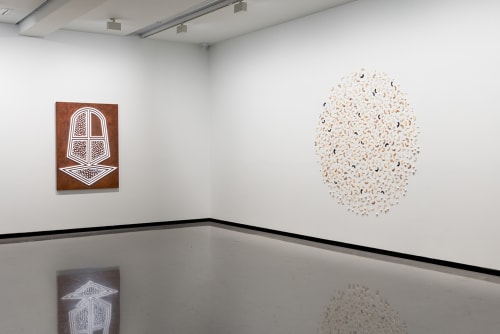“Traditionally, we carve mother of pearl, ebony, trochus, turtle shell and dugong bone."
Darrell Sibosado is included in Awakening Histories with his works Niman Aarl (Many Fish) and Umbun (Eagle Ray).
Awakening Histories traces the deep connections between First Nations peoples and Southeast Asian seafarers from the port of Makassar in South Sulawesi, Indonesia, celebrating enduring relationships that remain prominent in art, language and material culture.
Featuring new commissions and key loans, the twenty-seven artists and collectives presented in this exhibition share stories of migration, trade and cultural exchange, highlighting the roles of trepang or sea cucumber, trochus and turtle shells, tamarind trees, palm wine, seafaring technology, metal tools, textiles and patterns in histories shared across the ocean. Artworks reflect on stories and songs of the interactions that have taken place across the north of this continent, now known as Australia, from the Gulf of Carpentaria, around Arnhem Land to Garamilla/Darwin—an area known as Marege to the sailors from Makassar—and beyond to the Kimberley region, or Kayu Djawa.
While the origin of the trepang trade is unknown, the displacement of landowners in the Sultanate of Gowa in South Sulawesi by Dutch colonists in the seventeenth century spurred its growth as an alternative source of income. The trepangers were mostly of Makassan, Bugis and Malay ethnicity and are considered the first people to practice Islam on this continent. Large fleets of praus or sailing vessels arrived on the trade winds each year, their crews collecting and processing trepang over several months until the winds changed and they sailed home with cargoes destined for consumption in China. This was an international trade, negotiated with the sovereign peoples of Marege and Kayu Djawa. Towards the end of the nineteenth century, however, the South Australian Government began to impose import duties and then licensing fees on the praus. In 1906, the licenses were cancelled–-in line with the White Australia Policy– effectively banning a centuries-old trade.
Foregrounding Indigenous sovereignty and ocean-centred storytelling, Awakening Histories reinforces the understanding of Country as sea, sky and land, the passing of knowledge through families and generations—living histories that counter assumptions that this land’s peoples were isolated or that it was ‘discovered’ by Europeans during colonial expansion. The exhibition aims to shift understandings of this country’s history and contribute to the dialogue around First Nations ways of knowing and being, reasserting sovereignty.
This exhibition is taking place on Boonwurrung, Bunurong and Wurundjeri Country, the unceded lands of the Kulin Nations.

